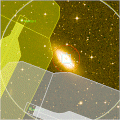
| You are in: Observing Tool (OT) > Science Program > Loading and Saving |
 |
Loading and Saving Science Programs |
Science programs may reside in three locations: (a) in the Gemini Observing Database, (b) in a local database on your hard disk or (c) in an export file on your hard disk. Retrieval and storage of programs from these locations, and the important differences between them, are described below.
Phase I proposals that have been approved by the ITAC and Gemini Director will be translated into the Observing Tool "Science Program" format and stored in a database at the Observatory. Soon after notification of a successful proposal you will receive a password and database access instructions. As the first step you should retrieve your science program(s) using the file...fetch item in the science program editor menu.
After completion of Phase II observation definition you should set the appropriate observation's status flags and upload your program back into the database using the file...store item.
Further information about the Observing Database describes the fetch and store features in more detail and highlights the importance of the observation status flag.
Science programs that are imported from XML files or retrieved from the Gemini database are stored in a local database on your hard disk. Having stored a science program once, in future sessions you should open it from the local database if you wish to avoid creating multiple instances of the program.
Whenever a change is made to a science program (e.g. editing an observation details) and accepted either explicitly by clicking on the save button in the lower right corner of the detailed program editors or implicitly by selecting a new element in the science program, the modified program is automatically saved to the local database.
![]() Note that after a
change has been accepted there is one level of undo available to revert to the former
or changed parameters. This is effected from the undo / redo button on
each component. Click-and-hold the edit pencil to transiently see any
pending changes.
Note that after a
change has been accepted there is one level of undo available to revert to the former
or changed parameters. This is effected from the undo / redo button on
each component. Click-and-hold the edit pencil to transiently see any
pending changes.
You can open science programs from the local database, either into the current or a new science program editor, and delete programs in the database from the file...open/delete menu items.
The local database is stored on your hard disk. Under Windows 9x this is in the Windows\.jsky\spdb folder (note there is a period before jsky). Under Windows NT and XP the .jsky folder is stored in Document and Settings\[user name]. Under Solaris and Linux the path is [home directory]/.jsky/spdb. These are binary files and cannot be edited. If you have unwanted multiple copies you can delete these files directly (or move them to a different directory).
![]() Note the binary
spdb files cannot be transferred directly into a new version of the OT. If you
wish to (re-)use previous science programs in a new OT release you should first
export the database into XML format as described below.
Note the binary
spdb files cannot be transferred directly into a new version of the OT. If you
wish to (re-)use previous science programs in a new OT release you should first
export the database into XML format as described below.
Science programs can be written to disk as XML files e.g. for communicating with co-Is and safe-keeping. These eXtensible Markup Language files consisting of ASCII tags and values. The file structure is complex and therefore it is not advisable to edit the XML directly.
You can save and load XML files from the file...import/export XML menu items. Each imported XML file is stored as a separate science program in the local database. If a science program with the same program reference number already exists you will be prompted to cancel the file load or continue. In the latter case a temporary program reference number with format <ref number>-copy<n> is assigned.
You can import and export an entire directory of XML files with one action. This is useful if you wish to transfer files into a new version of the Observing Tool (because the binary files in spdb cannot be transferred directly).
As the Observing Tool is still developmental software it cannot be assured that future versions will be backwards compatible with currently saved files.
Last update June 23, 2003; Phil Puxley